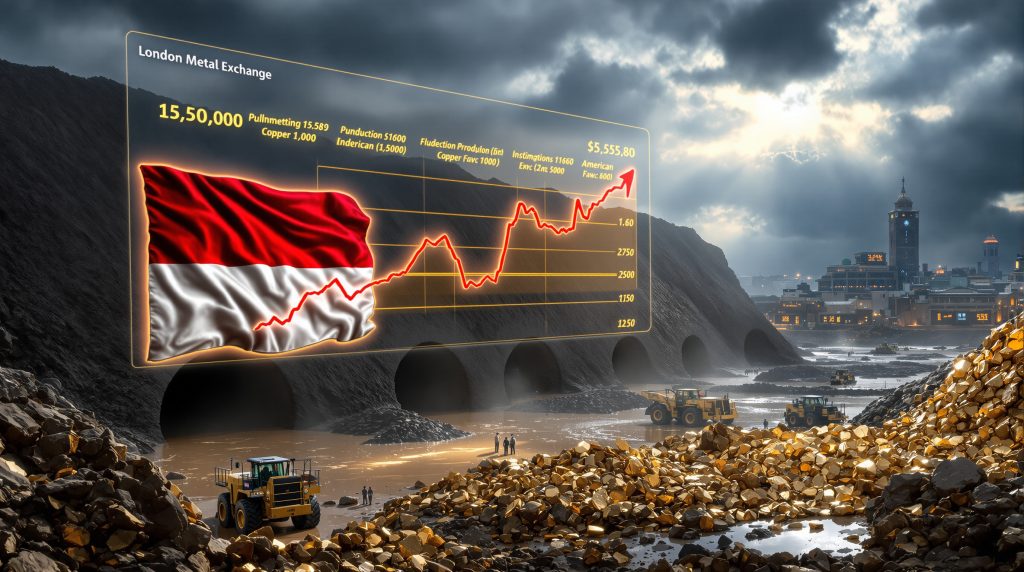What Happened at Freeport-McMoRan's Grasberg Mine?
The global copper market received a substantial shock when Freeport-McMoRan force majeure announcement at its flagship Grasberg mine in Indonesia. Following a tragic mud rush accident that claimed the lives of workers in September 2025, operations at one of the world's most significant copper and gold mining complexes came to a complete halt. The incident triggered an immediate market reaction, with Freeport-McMoRan's stock price plummeting nearly 12% as investors processed the news and its implications for global copper supply forecast.
The mud rush—a sudden and dangerous inflow of water, mud, and debris into underground mining areas—created hazardous conditions that blocked access routes throughout critical sections of the underground mining complex. These unsafe working conditions necessitated the complete suspension of operations while rescue efforts, investigations, and safety assessments were conducted.
The Triggering Incident
Indonesian mining operations have historically faced challenging geological conditions, with underground environments particularly susceptible to stability issues. The September 2025 incident highlighted the inherent risks of large-scale underground mining, even with modern safety protocols in place. According to mining safety experts, mud rushes are among the most feared hazards in underground operations due to their unpredictable nature and potentially catastrophic consequences.
The Indonesian Ministry of Energy and Mineral Resources immediately launched an investigation following the incident, with preliminary findings suggesting that unusually heavy rainfall combined with specific geological conditions may have contributed to the disaster. The full investigation is expected to continue for several months before final determinations are made regarding causation and preventative measures.
Understanding Force Majeure in Mining Operations
Force majeure represents a critical legal mechanism in the mining industry, enabling companies to temporarily suspend contractual obligations during extraordinary circumstances beyond their control. Black's Law Dictionary defines it as "an unforeseeable circumstance that prevents someone from fulfilling a contract," providing mining operators with necessary legal protection during unforeseen disruptions.
For Freeport-McMoRan, the declaration allows the company to legally notify customers, suppliers, and partners that they cannot fulfill previously agreed metal delivery schedules without facing contractual penalties. This legal shield is particularly important given Grasberg's significant contribution to global copper supplies and Indonesia's economic interests.
Mining industry analyst John Davidson noted that "force majeure declarations in the mining sector are relatively rare but have significant ripple effects when they occur at operations of Grasberg's scale. The last comparable event happened during the 2019 Chuquicamata transition in Chile, though with less severe market implications."
The formal notification process typically involves detailed documentation about the triggering event, estimated recovery timelines, and regular updates to affected commercial counterparties. For an operation of Grasberg's scale, this process involves coordination with dozens of major customers across multiple continents.
How Will This Affect Freeport-McMoRan's Production Targets?
The immediate consequence of the force majeure at Grasberg has been a dramatic downward revision in Freeport-McMoRan's production forecasts. The company's third-quarter 2025 production expectations have been substantially reduced, creating significant concern among investors and copper market participants.
Based on previous quarterly reporting, Freeport-McMoRan's Indonesian operations typically contribute approximately 35% of the company's global copper output. With these operations completely offline following the incident, the company faces a substantial shortfall that cannot be easily offset by increasing production at other sites. Industry analysts estimate the production loss could reach 400-500 million pounds of copper if operations remain suspended through the end of 2025.
Revised Production Forecasts
Prior to the incident, Freeport-McMoRan had projected consolidated copper sales of approximately 1.05 billion pounds for the third quarter of 2025. Following the Freeport-McMoRan force majeure announcement, market analysts expect this figure to be revised downward by at least 30-35%, reflecting the complete suspension of Indonesian operations for the quarter's remaining weeks.
Gold production—a valuable by-product of Grasberg's operations—will likewise see significant reductions. The site typically produces approximately 400,000 ounces of gold per quarter, making it one of the world's most productive gold mines as well. This dual impact on both copper and gold output creates a complex financial challenge for Freeport-McMoRan.
Mining consultant Robert Chang explains: "Underground mining operations can't simply be paused and restarted like a factory production line. Each day of inactivity creates compounding challenges, from water management to ground stability monitoring. The ramp-up period following a major safety incident typically takes months, not weeks."
The projected timeline for resuming operations remains uncertain, though most industry observers expect a phased approach beginning in early 2026. The company will likely prioritize the safest portions of the underground complex initially, gradually expanding operations as safety assessments and remediation efforts progress.
Financial Implications for Freeport-McMoRan
The financial impact extends beyond direct production losses. Freeport-McMoRan faces substantial remediation costs, ongoing labor expenses despite halted production, and potential liability concerns related to the incident. These factors contributed to the immediate stock price decline of nearly 12% following the announcement.
Insurance coverage will likely offset some of the financial damage, as most major mining companies maintain comprehensive business interruption policies. However, insurance rarely covers the full spectrum of costs associated with major operational disruptions, particularly reputational damage and long-term market share losses.
The company's capital expenditure plans may also require adjustment if remediation costs exceed initial estimates. Prior to the incident, Freeport-McMoRan had announced plans for approximately $3.7 billion in capital expenditures for 2025, with a significant portion allocated to underground development at Grasberg. These funds may now be partially redirected toward safety enhancements and operational recovery efforts.
What Makes Grasberg Mine So Significant?
The Grasberg mining complex represents one of the crown jewels of the global mining industry, distinguished by its exceptional mineral endowment and strategic importance to both Freeport-McMoRan and Indonesia. Located in the remote highlands of Papua, Indonesia, the operation has evolved from its original open-pit configuration to a sophisticated underground mining system following years of planning and billions in capital investment.
According to the U.S. Geological Survey's Mineral Commodity Summaries, Grasberg ranks among the world's top three copper mines by reserve size and production capacity. Its significance extends beyond simple production figures to encompass geopolitical considerations, technological innovation, and economic development for Indonesia.
Strategic Importance of the Grasberg Operation
Grasberg's uniqueness stems from its remarkable combination of high copper grades and substantial gold content—a geological rarity that makes it exceptionally valuable. The mine produces copper at grades averaging 0.96%, significantly higher than the global average of approximately 0.6% for operating copper mines. This grade advantage translates to lower production costs per pound when operations run smoothly.
For Indonesia, the mine represents a critical source of export revenue, employment, and technological development. The operation employs over 30,000 people directly and indirectly, making it one of the country's largest private employers. Tax and royalty payments from the mine constitute a significant portion of Indonesia's annual resource-related government revenue.
From Freeport-McMoRan's perspective, Grasberg provides approximately one-third of the company's global copper production and the majority of its gold output. This concentration of value in a single operation creates both strategic advantages and risk management challenges that the current force majeure situation has brought into sharp focus.
Historical Context of Grasberg
Grasberg's development trajectory illustrates the evolving nature of world-class mining operations. Originally developed as an open-pit mine in the 1980s, the operation began its transition to underground mining in 2019 as surface reserves approached depletion. This transition represented one of the mining industry's most ambitious engineering projects, requiring approximately $15 billion in capital expenditure over a multi-year period.
The underground development includes several distinct mining zones, including the Deep Mill Level Zone (DMLZ) and the Grasberg Block Cave. These sophisticated mining systems use gravity and controlled fracturing to extract ore from large underground volumes, creating unique operational challenges and safety considerations compared to traditional underground mining methods.
Prior to the current force majeure event, Grasberg had experienced several other operational challenges throughout its history. Labor disputes in 2011 and 2017 temporarily reduced production, while periodic disagreements between Freeport-McMoRan and the Indonesian government regarding ownership structures, taxation, and environmental regulations created periods of uncertainty. The 2018 agreement that gave Indonesia majority ownership while maintaining Freeport-McMoRan's operational control represented a landmark resolution to these long-standing tensions.
How Is This Affecting Global Copper Markets?
The sudden disruption at one of the world's premier copper mining operations has sent shockwaves through global metals markets, with implications extending from trading floors to manufacturing facilities worldwide. Copper's critical role in electrical infrastructure, renewable energy systems, and modern manufacturing makes supply disruptions particularly impactful across multiple economic sectors.
Following the Freeport-McMoRan force majeure announcement, copper price predictions surged dramatically, with futures on the London Metal Exchange reaching levels not seen in 15 months. The intensity of the market reaction reflects both Grasberg's significance as a supplier and the already tight global copper supply situation that preceded the incident.
Immediate Market Response
Trading volumes increased substantially in the days following the announcement as market participants repositioned their exposure to what many analysts described as a "fundamentally altered" supply outlook for the remainder of 2025 and early 2026. Price volatility metrics reached levels typically seen only during major macroeconomic events, highlighting the metal's sensitivity to significant supply disruptions.
Commodity trading firms reported unusual activity in options markets, with particular interest in upside price protection through the first half of 2026—the period most likely to be affected by Grasberg's reduced output. This options activity suggests widespread market expectation that price impacts will extend well beyond the immediate aftermath of the force majeure declaration.
Industrial consumers of copper, particularly those without substantial inventory buffers or long-term supply agreements, face potential challenges securing physical metal at predictable prices. Spot market premiums for physical delivery have increased substantially, especially in Asian markets that rely heavily on Indonesian copper supplies.
Long-Term Supply Implications
The broader context surrounding Grasberg's disruption amplifies its market significance. Global copper inventories on major exchanges had already declined to historically low levels in mid-2025, with less than one week of global consumption available in visible storage. This tight inventory situation provides little buffer against major supply disruptions.
Global copper mining faces additional structural challenges that limit the industry's ability to quickly compensate for Grasberg's reduced output. Average ore grades at producing mines continue their long-term decline, requiring more material to be processed for each pound of copper produced. Meanwhile, development timelines for new copper projects regularly exceed 10 years from discovery to production due to regulatory, environmental, and financing hurdles.
Mining industry economist James Wilson observed: "The copper market was already projected to enter a significant supply deficit by 2027 due to accelerating demand from electrification trends and insufficient project development. Grasberg's disruption potentially brings that inflection point forward by 12-18 months, depending on the recovery timeline."
For copper-intensive industries, these supply challenges raise strategic questions about inventory management, pricing strategies, and potential material substitution where technically feasible. The renewable energy and electric vehicle sectors face particular exposure to copper supply constraints given their rapid growth trajectories and limited substitution options.
What Compounding Factors Are Affecting Freeport's Operations?
The force majeure at Grasberg occurs against a backdrop of multiple operational challenges that complicate the recovery timeline and amplify the disruption's significance. These compounding factors extend beyond the immediate safety concerns to encompass logistical, technical, and regulatory dimensions that must be addressed before normal operations can resume.
Among the most significant complicating factors is the reported damage to Freeport's Indonesian smelting facility from a separate incident in 2024. This previously damaged infrastructure creates additional hurdles for processing and exporting copper concentrates once mining operations eventually resume.
Pre-Existing Operational Challenges
Indonesia's strict mineral processing requirements prohibit the export of unprocessed copper concentrates, mandating domestic smelting and refining. With Freeport's domestic smelting capacity compromised from the previous incident, the company faces a processing bottleneck even after mining operations restart. Temporary regulatory exemptions may be required to allow concentrate exports during the recovery period.
The remote location of Grasberg creates substantial logistical complexities for the recovery effort. Situated at elevations exceeding 14,000 feet in one of Indonesia's most inaccessible regions, the mine depends on specialized infrastructure for personnel transportation, equipment delivery, and concentrate shipment. This remoteness extends timelines for bringing in specialized recovery equipment and technical experts.
Underground mining systems like those employed at Grasberg involve intricate ventilation, dewatering, and ground support systems that require continuous maintenance. The operational suspension creates additional technical challenges as these systems require careful monitoring and restoration before mining activities can safely resume.
Recovery Timeline Considerations
Safety assessment protocols following a serious incident like the September mud rush involve multiple phases, beginning with stabilization of affected areas and progressing through detailed geological analysis. These assessments typically require input from external engineering firms, regulatory authorities, and safety specialists, creating a necessarily deliberate process that resists acceleration.
Mining safety consultant Elizabeth Chen explains: "Underground mining recoveries following major ground control incidents involve a systematic, phased approach. Each section must be individually assessed for stability, remediated where necessary, and then certified safe before personnel can return. Attempting to shortcut this process dramatically increases the risk of secondary incidents."
The regulatory approval process adds another layer of complexity. Indonesian mining authorities will require comprehensive documentation of remediation efforts, updated safety protocols, and preventative measures before allowing operational resumption. This regulatory review typically involves multiple government agencies and can extend recovery timelines by several weeks or months.
Workforce training and confidence restoration represent critical elements of the recovery process. Mining personnel returning to underground environments following serious safety incidents require additional training, psychological support, and confidence-building measures. The effectiveness of these human factors significantly influences productivity during the initial restart phases.
What Does This Mean for Copper-Dependent Industries?
The ripple effects from Grasberg's disruption extend far beyond the mining sector to impact multiple industries where copper serves as an essential input. From electronics manufacturing to construction and renewable energy development, copper-intensive sectors now face supply uncertainty during a period of already challenging market conditions.
According to the International Copper Association, electronics manufacturing accounts for approximately 28% of global copper consumption, with construction representing an additional 31%. Both sectors face potential material constraints and price pressures as Grasberg's output remains offline during the recovery period.
Downstream Impact Analysis
Electronics manufacturers operate in particularly vulnerable positions, with copper wiring, circuitry components, and cooling systems representing irreplaceable elements in most devices. Companies with just-in-time inventory strategies face the greatest exposure, potentially leading to production adjustments if copper availability constrains manufacturing processes.
The construction sector, while somewhat more flexible in project timelines, relies heavily on copper for electrical systems, plumbing components, and HVAC equipment. Projects in the planning and bidding phases now face additional cost uncertainty as copper price volatility complicates budgeting and contract negotiations.
Perhaps most significantly, renewable energy projects—particularly utility-scale solar and wind installations—require substantial copper inputs for generators, transformers, and transmission infrastructure. The International Energy Agency estimates that renewable energy systems require 4-5 times more copper per megawatt than traditional power generation, creating heightened sensitivity to supply disruptions.
The electric vehicle sector represents another copper-intensive growth industry facing potential challenges. Each battery-electric vehicle contains approximately 180 pounds of copper—nearly four times the amount found in conventional vehicles. As automakers accelerate electric vehicle production, their exposure to copper demand surge increases proportionally.
Strategic Responses from Copper Consumers
Major industrial consumers have begun implementing strategic responses to mitigate the impact of Grasberg's disruption. These strategies include accelerated inventory building where storage capacity and financing allow, exploration of supply diversification options, and in some cases, production schedule adjustments to prioritize products with lower copper intensity.
For companies with sophisticated commodity risk management programs, expanded hedging activities provide some protection against price volatility. However, hedging strategies primarily address price risk rather than physical availability constraints, leaving operational vulnerabilities for products that cannot be manufactured without specific copper inputs.
Material substitution represents another potential strategy, though with significant limitations. Aluminum can replace copper in some electrical applications, though with performance tradeoffs in conductivity, connection reliability, and space requirements. Substitution options remain highly limited for many high-performance electronics applications where copper's unique properties prove essential.
Industry associations have begun coordinating information-sharing initiatives to help member companies navigate the supply disruption. These collaborative efforts include market intelligence sharing, supplier diversification resources, and technical support for evaluating material substitution options where feasible.
How Are Other Mining Companies Responding?
The disruption at Grasberg creates both challenges and strategic opportunities for other copper producers worldwide. Major mining companies with operational copper assets are carefully evaluating production optimization possibilities, development timelines for expansion projects, and exploration priorities in response to altered market conditions.
The world's largest copper producers—including Chile's Codelco, BHP, Anglo American, and Rio Tinto—possess the greatest capacity to increase output in response to Grasberg's shortfall. However, most major operations already run at or near maximum sustainable production rates, limiting the potential for rapid supply increases without compromising equipment reliability or safety standards.
Competitive Positioning
Several copper producers with expansion projects nearing completion now face decisions about potentially accelerating development timelines. Projects in the commissioning phase may prioritize reaching commercial production sooner than originally scheduled, though with careful attention to the technical risks associated with compressed ramp-up periods.
Chile's mining minister recently indicated that the country's producers are evaluating opportunities to optimize output while maintaining operational stability: "Chile's copper sector recognizes its responsibility to global supply chains during disruptions while ensuring sustainable production practices that protect worker safety and equipment integrity."
Exploration activity has seen renewed interest, with particular focus on advanced-stage copper projects that could potentially enter development within the next 24-36 months. Junior mining companies with promising copper discoveries report increased interest from potential strategic partners and investors seeking exposure to near-term production opportunities.
Mining companies with polymetallic operations containing copper as a secondary product are reexamining mine plans to potentially prioritize copper-rich zones where geologically and operationally feasible. These tactical adjustments could incrementally increase global copper availability without requiring new mine development.
Safety Protocol Evaluations
The incident at Grasberg has triggered industry-wide reviews of safety protocols for underground mining operations, particularly those using block cave and panel cave mining methods similar to Grasberg's underground systems. These reviews focus on ground stability monitoring, water management systems, and emergency response capabilities.
Leading mining companies are conducting comprehensive risk assessments of their underground operations, with particular attention to geological conditions similar to those implicated in the Grasberg mud rush. These preventative evaluations aim to identify potential vulnerabilities before they manifest as safety incidents.
Technology investments for enhanced safety monitoring have accelerated, with increased interest in real-time ground movement detection systems, advanced water monitoring networks, and improved personnel tracking capabilities. These innovative mining technologies enable earlier detection of developing hazards and more effective emergency responses when incidents occur.
Industry collaboration through mining safety organizations has intensified, with multiple technical workshops scheduled to share learnings and best practices for mud rush prevention and management. This collaborative approach reflects recognition that safety advances benefit the entire industry rather than providing competitive advantages to individual companies.
What Are The Investment Implications?
The Freeport-McMoRan force majeure announcement creates a complex landscape for investors across multiple sectors, from mining equities to industrial metals ETFs and downstream manufacturing companies. Understanding these investment implications requires analysis of both immediate market reactions and potential longer-term structural impacts on the copper supply-demand balance.
Mining equities have shown predictable but nuanced responses to the force majeure announcement. Freeport-McMoRan experienced an immediate share price decline of nearly 12% as investors processed the production impact and potential financial consequences. Other major copper producers generally saw modest share price increases as the market anticipated potential benefits from higher copper prices and market share opportunities.
Market Sentiment Analysis
Investment sentiment toward mining equities typically demonstrates a pattern following major operational disruptions, beginning with risk aversion toward directly affected companies before transitioning to more nuanced evaluation of competitive position changes across the sector. This evolution appears to be following historical patterns, with initial indiscriminate selling giving way to more targeted investment positioning.
Companies with spare production capacity, near-term development projects, or strategic copper reserves have attracted particular investor interest following the announcement. This selective approach reflects growing sophistication among resource investors regarding the structural implications of major supply disruptions rather than simple momentum-based trading.
The risk premium associated with geologically complex underground mining operations has increased notably, with companies operating similar mining methods facing greater investor scrutiny regarding safety protocols and operational contingency plans. This reassessment could influence capital allocation decisions and valuation multiples for companies with significant exposure to technically challenging mining methods.
Options market activity suggests substantial uncertainty regarding near-term copper price movements, with implied volatility metrics reaching multi-year highs. This uncertainty creates both challenges and opportunities for investors with different risk tolerances and investment horizons.
Long-Term Investment Considerations
Beyond immediate market reactions, the Grasberg disruption potentially accelerates several structural trends affecting long-term copper market dynamics. These developments warrant consideration from investors with multi-year horizons and those evaluating strategic positioning across the metals and mining sector.
The global copper market was already projected to enter a period of structural deficit as demand growth from electrification trends outpaces new mine development. Industry forecasts before the Grasberg incident suggested a potential supply gap of 4-6 million tonnes annually by 2030 if currently identified projects progress as scheduled. Grasberg's disruption potentially widens this projected gap if it leads to permanent production capacity reductions or development delays.
Exploration-stage copper projects may experience valuation reassessments as the strategic importance of future copper supply becomes increasingly apparent. Junior mining companies with significant copper resources but lengthy development timelines had experienced limited investor interest during recent years but could benefit from renewed attention to long-term supply development.
Geopolitical considerations surrounding copper supply security have gained prominence, with implications for projects in politically stable jurisdictions. Investment capital may increasingly differentiate between copper assets based on jurisdictional risk factors, potentially benefiting projects in mining-friendly regions despite potentially higher operating costs.
The dramatic movement in copper prices has also created interesting correlations with record-high gold prices, as investors seek safe-haven assets during periods of commodity market volatility.
FAQ: Key Questions About the Force Majeure
What exactly is a "mud rush" in mining terminology?
A mud rush refers to a sudden and uncontrolled inflow of liquefied material into underground mining areas. These events occur when water combines with rock and soil to create a liquid or semi-liquid mass that can flow rapidly through underground openings. Mud rushes represent particular dangers in block cave mining operations like Grasberg, where large volumes of fractured rock create complex water pathways. Prevention systems typically include extensive drainage infrastructure, continuous monitoring, and careful control of underground water sources.
How long do force majeure declarations typically last in mining operations?
The duration of force majeure periods varies significantly based on incident severity, remediation requirements, and regulatory processes. For minor operational disruptions, force majeure might last only weeks. However, major safety incidents involving fatalities and complex underground environments typically result in force majeure periods lasting 6-12 months or longer. The 2018 force majeure at Vale's Brucutu iron ore mine in Brazil following a tailings dam failure lasted approximately eight months, while the 2010 force majeure at Chile's San José copper-gold mine following a major collapse extended for over a year before full production resumed.
Will this event affect global copper prices for consumers?
Copper price increases following major supply disruptions typically cascade through manufacturing supply chains, eventually reaching consumer products with significant copper content. Electronic devices, electrical equipment, and construction materials containing substantial copper components will likely experience modest cost increases if copper prices remain elevated for extended periods. However, copper typically represents a small percentage of total costs for most consumer products, limiting the direct impact on retail prices. Commercial construction projects face more substantial exposure due to the higher proportion of copper in overall project costs, potentially affecting development economics for projects in the planning phases.
What safety measures might be implemented before operations resume?
Before underground operations can safely resume, mining companies typically implement multiple safety enhancements based on incident investigations and risk assessments. These measures often include improved drainage systems with increased capacity, enhanced ground monitoring technologies to detect movement or water accumulation, additional emergency escape routes, and revised operational procedures for areas with identified geological risk factors. Regulatory authorities typically require demonstration of these improvements through comprehensive documentation and physical inspections before allowing resumption of full-scale mining activities. Personnel training represents another critical component, ensuring all underground workers understand updated safety protocols and emergency response procedures specific to mud rush risks.
Ready to Stay Ahead of Major Mining Discoveries?
Don't miss the next market-moving mineral discovery on the ASX. Discovery Alert's proprietary Discovery IQ model delivers real-time notifications on significant mineral discoveries, helping investors act before the broader market. Explore historic examples of exceptional returns on our discoveries page and position yourself for success.




